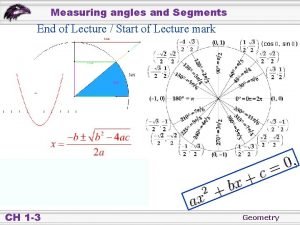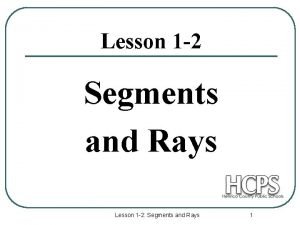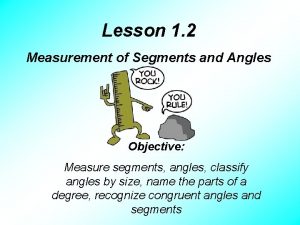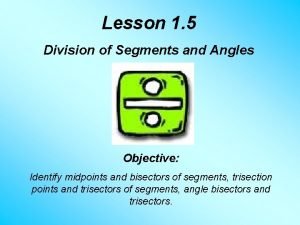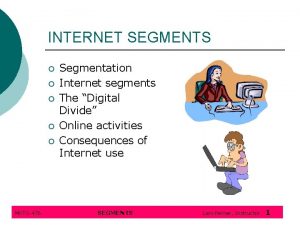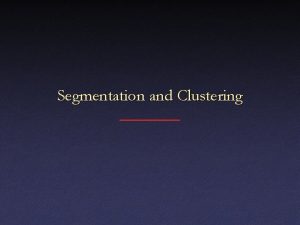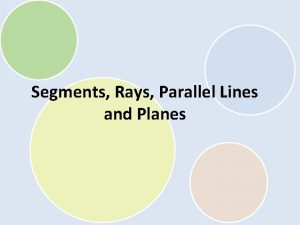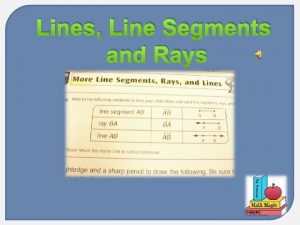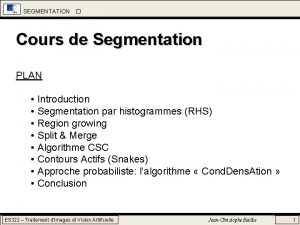Segmentation and Segments How is it defined Segmentation










- Slides: 10

Segmentation and Segments • How is it defined? • Segmentation - Dividing a market or potential market into groups that have similarities within each group and differences across groups • Segments - Groups that have similarities within each group and differences across groups based on characteristics or behavior • What are the impacts? • Defines the scope of the market in a meaningful way • Allows for allocation of marketing resources • Drives the implementation of the 4 -P’s • When is it used or not used? • Should ALWAYS be used BEFORE deciding which groups to reach or not • Impacts which offers and products will be used • Example: Buyers needing four wheel drive and buyers not needing four wheel drive have differences which could drive the choice to use 4 wheel drive for segmentation

Requirements for Segments • How is it defined? • Marketing segments should be meaningfully different from each other, substantial, quantifiable, and responsive • What are the impacts? • Substantial segments “big enough to justify a specific effort” • Quantifiable segments can be counted and reached • Responsive segments will respond (or not) to an offer of an exchange • When is it used or not used? • When developing products, offers, and communication to groups of people • When considering marketing costs (both fixed and variable) for a product • Example: Segments are groups of individuals or organizations that together comprise markets

Bases for Segments • How is it defined? • The characteristics and/or behaviors that are used to define and separate segments • What are the impacts? • Determines how segments will be built and measured • May pertain to ability and willingness to buy • May pertain to type of use or reason for use of a product • When is it used or not used? • In planning and strategy phases • Specific points may be dependent upon availability of information or data • Example: Four wheel drive or two wheel drive can be bases for segmenting the truck market, elderly or young but injured could be bases for segmenting the wheel chair market.

Summary of Learning Buying Behavior Lifestyles Bases for Market Segmentation Geographic Location Age and Income

Targeting and Targets • How is it defined? • Targeting - The process of deciding which segments to select and how resources should be allocated • Targets - The segments that are NOT de-selected • What are the impacts? • Determines why an organization will expend marketing resources • A key challenge for targeting is deciding what NOT to select • Another key challenge is how to prioritize targets • When is it used or not used? • Targeting is not used when bases for segmentation cannot be met • Targeting is not used when a single marketing message is deployed to all markets, regardless of whether or not segments are perceived • Example: A grocery store targets moms because families with children buy more groceries than single people or elderly couples. A grocery store does not target (de-selects) single college-age men, even though they may be defined in the segments making up the market.

Differentiated Strategy • How is it defined? • Targeting multiple segments with a meaningful difference in the 4 -P’s • What are the impacts? • Greater fixed costs to create different products and offers • Greater variable costs to maintain greater product selection or reach specific targets • Potential for higher profit if greater value is perceived by buyers • When is it used or not used? • When segments have different product needs or when segments buy in different ways or places • When profit potential exceeds added costs • Example: Marketing four wheel drive trucks to people in the north and two wheel drive trucks to people in the south is a differentiated strategy

Concentrated Strategy • How is it defined? • Targeting only one segment and ignoring others, or pursuing a niche marketing strategy • What are the impacts? • Ideal for small, specialized organizations • May limit growth or sales • May protect the organization from competitors • When is it used or not used? • When a marketer has a geographic advantage or limitation, or when marketers have limited resources versus potential competitors • When a marketer has expertise or notoriety in a specific area • Example: A world-champion snowboarder marketing snowboards only is concentrated in the snowboard market and potential ignoring downhill and crosscountry skiing customers

Undifferentiated Strategy • How is it defined? • Marketing with no distinction among segments or targets • What are the impacts? • Lowest fixed costs due to common products and communication • Lowest variable cost of communication by allowing lowest cost media choices • May miss opportunities to serve specialized needs at a higher margin • When is it used or not used? • Very common products like table salt or canned vegetables • Rarely possible or ideal due to buyer, seller, constituent relationships including business and consumer markets; when tailoring products and offers to targets adds more value than cost • Example: Morton table salt is marketed to pretty much everyone the same way, there is no difference in strategy for men or women, young or old

Summary of Learning Differentiated Concentrated Undifferentiated Highest Fixed and Variable Cost Lowest Short. Term Risk Lowest Fixed and Variable Cost Highest Potential Profit Lowest Potential Profit Rarely possible or ideal

Marketing Concepts An on-line course for advanced degree-seeking professionals
 Well defined set example
Well defined set example Measuring segments and angles
Measuring segments and angles Marketing simulation: managing segments and customers v3
Marketing simulation: managing segments and customers v3 Ray location postulate
Ray location postulate Postulates examples
Postulates examples Measurement of segments and angles
Measurement of segments and angles 15-4 segment relationships in circles
15-4 segment relationships in circles Identifying market segments and targets chapter 9
Identifying market segments and targets chapter 9 Identifying market segments and targets chapter 9
Identifying market segments and targets chapter 9 10-5 secant lines and segments
10-5 secant lines and segments Division of segments and angles
Division of segments and angles

